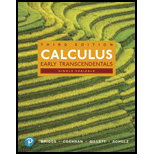
Calculus, Single Variable: Early Transcendentals (3rd Edition)
3rd Edition
ISBN: 9780134766850
Author: William L. Briggs, Lyle Cochran, Bernard Gillett, Eric Schulz
Publisher: PEARSON
expand_more
expand_more
format_list_bulleted
Question
Chapter C, Problem 37E
To determine
To compute: The polar form of the
Expert Solution & Answer
Want to see the full answer?
Check out a sample textbook solution
Students have asked these similar questions
Consider the function f(x) = x²-1.
(a) Find the instantaneous rate of change of f(x) at x=1 using the definition of the derivative.
Show all your steps clearly.
(b) Sketch the graph of f(x) around x = 1. Draw the secant line passing through the points on the
graph where x 1 and x->
1+h (for a small positive value of h, illustrate conceptually). Then,
draw the tangent line to the graph at x=1. Explain how the slope of the tangent line relates to the
value you found in part (a).
(c) In a few sentences, explain what the instantaneous rate of change of f(x) at x = 1 represents in
the context of the graph of f(x). How does the rate of change of this function vary at different
points?
1. The graph of ƒ is given. Use the graph to evaluate each of the following values. If a value does not exist,
state that fact.
и
(a) f'(-5)
(b) f'(-3)
(c) f'(0)
(d) f'(5)
2. Find an equation of the tangent line to the graph of y = g(x) at x = 5 if g(5) = −3 and g'(5)
=
4.
-
3. If an equation of the tangent line to the graph of y = f(x) at the point where x 2 is y = 4x — 5, find ƒ(2)
and f'(2).
Does the series converge or diverge
Chapter C Solutions
Calculus, Single Variable: Early Transcendentals (3rd Edition)
Ch. C - Practice Exercises Complex operations Let z = 2 +...Ch. C - Prob. 2ECh. C - Prob. 3ECh. C - Prob. 4ECh. C - Prob. 5ECh. C - Prob. 6ECh. C - Prob. 7ECh. C - Prob. 8ECh. C - Prob. 9ECh. C - Prob. 10E
Ch. C - Prob. 11ECh. C - Prob. 12ECh. C - Prob. 13ECh. C - Prob. 14ECh. C - Prob. 15ECh. C - Prob. 16ECh. C - Prob. 17ECh. C - Prob. 18ECh. C - Prob. 19ECh. C - Prob. 20ECh. C - Prob. 21ECh. C - Prob. 22ECh. C - Prob. 23ECh. C - Prob. 24ECh. C - Prob. 25ECh. C - Prob. 26ECh. C - Prob. 27ECh. C - Prob. 28ECh. C - Prob. 29ECh. C - Prob. 30ECh. C - Prob. 31ECh. C - Prob. 32ECh. C - Prob. 33ECh. C - Prob. 34ECh. C - Prob. 35ECh. C - Prob. 36ECh. C - Prob. 37ECh. C - Prob. 38ECh. C - Prob. 39ECh. C - Prob. 40ECh. C - Prob. 41ECh. C - Prob. 42ECh. C - Prob. 43ECh. C - Prob. 44ECh. C - Prob. 45ECh. C - Prob. 46ECh. C - Prob. 47ECh. C - Prob. 48ECh. C - Prob. 49ECh. C - Prob. 50ECh. C - Prob. 51ECh. C - Prob. 52ECh. C - Prob. 53ECh. C - Prob. 54ECh. C - Prob. 55ECh. C - Prob. 56ECh. C - Prob. 57ECh. C - Prob. 58ECh. C - Prob. 59ECh. C - Prob. 60ECh. C - Prob. 61E
Knowledge Booster
Learn more about
Need a deep-dive on the concept behind this application? Look no further. Learn more about this topic, calculus and related others by exploring similar questions and additional content below.Similar questions
- Suppose that a particle moves along a straight line with velocity v (t) = 62t, where 0 < t <3 (v(t) in meters per second, t in seconds). Find the displacement d (t) at time t and the displacement up to t = 3. d(t) ds = ["v (s) da = { The displacement up to t = 3 is d(3)- meters.arrow_forwardLet f (x) = x², a 3, and b = = 4. Answer exactly. a. Find the average value fave of f between a and b. fave b. Find a point c where f (c) = fave. Enter only one of the possible values for c. c=arrow_forwardplease do Q3arrow_forward
- Use the properties of logarithms, given that In(2) = 0.6931 and In(3) = 1.0986, to approximate the logarithm. Use a calculator to confirm your approximations. (Round your answers to four decimal places.) (a) In(0.75) (b) In(24) (c) In(18) 1 (d) In ≈ 2 72arrow_forwardFind the indefinite integral. (Remember the constant of integration.) √tan(8x) tan(8x) sec²(8x) dxarrow_forwardFind the indefinite integral by making a change of variables. (Remember the constant of integration.) √(x+4) 4)√6-x dxarrow_forward
- a -> f(x) = f(x) = [x] show that whether f is continuous function or not(by using theorem) Muslim_mathsarrow_forwardUse Green's Theorem to evaluate F. dr, where F = (√+4y, 2x + √√) and C consists of the arc of the curve y = 4x - x² from (0,0) to (4,0) and the line segment from (4,0) to (0,0).arrow_forwardEvaluate F. dr where F(x, y, z) = (2yz cos(xyz), 2xzcos(xyz), 2xy cos(xyz)) and C is the line π 1 1 segment starting at the point (8, ' and ending at the point (3, 2 3'6arrow_forward
arrow_back_ios
SEE MORE QUESTIONS
arrow_forward_ios
Recommended textbooks for you
- Algebra & Trigonometry with Analytic GeometryAlgebraISBN:9781133382119Author:SwokowskiPublisher:Cengage

Algebra & Trigonometry with Analytic Geometry
Algebra
ISBN:9781133382119
Author:Swokowski
Publisher:Cengage
Complex Numbers In Polar - De Moivre's Theorem; Author: The Organic Chemistry Tutor;https://www.youtube.com/watch?v=J6TnZxUUzqU;License: Standard YouTube License, CC-BY